Overview
This article delves into the pivotal rules governing Self-Managed Super Fund (SMSF) lending, underscoring their importance for financial professionals who advise clients on retirement investments. Understanding SMSF lending regulations is not just beneficial; it is essential for ensuring compliance and crafting successful investment strategies. These regulations serve a dual purpose: they safeguard retirement savings and simultaneously enhance potential returns by leveraging superannuation for property acquisitions.
Furthermore, grasping these rules enables financial advisors to provide informed guidance, ultimately empowering clients to make sound investment decisions. As we explore the intricacies of SMSF lending, consider how these insights can transform your approach to retirement planning and investment strategies.
Introduction
In the realm of retirement planning, Self-Managed Super Funds (SMSFs) are carving out a significant niche, particularly through SMSF lending. This innovative approach empowers individuals to leverage their superannuation savings to acquire investment properties, promising not only potential growth but also enhanced control over their financial futures.
As the SMSF sector continues to flourish, boasting a staggering $990 billion in assets as of mid-2024, understanding the intricacies of SMSF lending becomes paramount.
Navigating stringent regulations and exploring various loan options are crucial; financial professionals and investors alike must grasp the nuances that can significantly impact their investment strategies.
This article delves into the critical aspects of SMSF lending, highlighting its importance, the associated risks, and best practices for maximizing retirement savings through savvy property investments.
What is SMSF Lending and Why It Matters
Self-Managed Super Funds (SMSFs) lending empowers these funds to borrow resources for the acquisition of investment properties or other assets, a practice increasingly embraced by investors keen on amplifying their retirement savings. This lending mechanism is particularly significant, as it enables members to leverage their superannuation savings for real estate investments, potentially leading to substantial growth in their retirement portfolios.
As of June 30, 2024, the self-managed superannuation fund sector has exhibited remarkable growth, with over 625,000 funds collectively managing $990 billion in assets. Notably, the average self-managed superannuation fund assets have surged by 21% over the past five years, underscoring a robust financial landscape for self-managed funds. The median self-managed super fund member balance stands at $411,000, with a significant portion—66%—of members aged 50 and above.
This demographic trend underscores the importance of SMSF lending as a strategic tool for retirement planning, especially for individuals nearing retirement.
The SMSF lending rules are stringent regulations designed to ensure compliance with superannuation laws. Financial professionals must be well-versed in SMSF lending rules to provide accurate advice to their clients. The ability to utilize superannuation funds for capital growth not only fosters wealth accumulation but also aligns with long-term financial strategies aimed at securing a comfortable retirement.
Experts in the field highlight the advantages of leveraging superannuation for property acquisitions. Financial advisors assert that the SMSF lending rules can afford members greater control over their financial options and the potential for enhanced returns compared to conventional superannuation funds. This sentiment is echoed by Shelley Banton, head of technical for ASF Audits, who states, "It's good news for the self-managed super fund industry, which continues to provide members with high-level compliance support, tailored investment advice, and educational initiatives."
This highlights the ongoing assistance available to self-managed superannuation fund members.
In 2025, SMSF lending rules remain a pivotal topic within the financial landscape, with continuous discussions regarding their impact on retirement savings. Finance Story is committed to assisting clients with commercial real estate ventures by offering customized advice for compliance and lender selection. Case studies illustrate successful real estate investments financed through SMSFs, showcasing how members have effectively enhanced their retirement savings through strategic asset acquisitions while adhering to SMSF lending rules.
Moreover, Finance Story's reputation for professionalism and extensive knowledge of the finance sector, along with its dedicated lending partner in the UK for expat loans, positions it as a reliable resource for clients navigating the SMSF lending rules. For those looking to build their own homes or invest in residential properties, Finance Story offers tailored funding solutions that cater to both first-time buyers and seasoned investors.
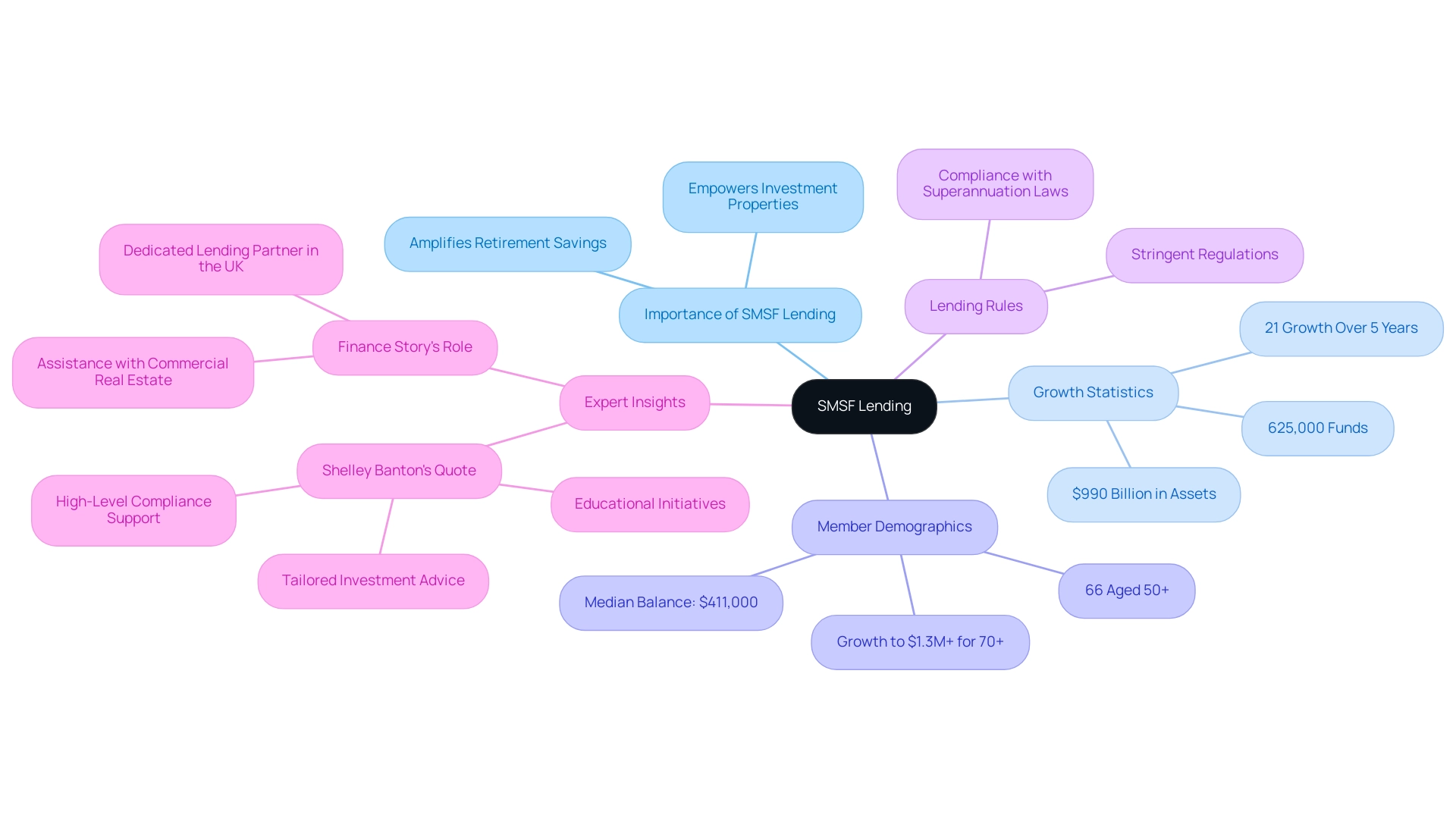
Key Regulations and Compliance Requirements for SMSF Lending
The SMSF lending rules governing self-managed superannuation fund lending are established by several critical regulations from the Australian Taxation Office (ATO). These regulations are essential for maintaining compliance and safeguarding the integrity of self-managed super funds. A fundamental requirement under the SMSF lending rules is that SMSFs can only engage in borrowing through a limited recourse borrowing arrangement (LRBA). This structure ensures that the lender's recourse is confined solely to the asset acquired with the borrowed funds, protecting the fund's other assets from potential claims.
Moreover, SMSFs must satisfy the sole purpose test, which mandates that the fund's primary objective is to provide retirement benefits to its members. This requirement is pivotal in ensuring that the self-managed superannuation fund operates within the legal framework designed to protect retirement savings.
Compliance entails several additional obligations, including the maintenance of accurate documentation and the execution of all transactions at arm's length. Importantly, the SMSF lending rules prohibit SMSFs from lending to members or their relatives, a measure designed to prevent conflicts of interest and ensure that the fund's assets are used solely for retirement purposes.
For small business owners aiming to invest in commercial real estate—such as office buildings, warehouses, and retail spaces—through SMSFs, comprehending the SMSF lending rules is essential. Finance Story provides customized advice to help manage the intricacies of self-managed super fund commercial property investments, ensuring compliance and aiding in lender selection. Recent statistics indicate that compliance breaches within the self-managed superannuation fund sector remain a concern, underscoring the necessity for financial professionals to stay informed about the latest SMSF lending rules and ATO regulations.
For instance, the ATO encourages auditors to stay informed about developments in self-managed super funds through their newsroom and monthly newsletters, which serve as valuable resources for updates and guidance. This proactive approach is crucial for maintaining compliance with the SMSF lending rules and optimizing the performance of SMSFs, especially given that the estimated return for SMSFs was reported at 10.1%, reflecting a significant increase from previous years.
Expert insights highlight the potential consequences of non-compliance. As noted by Tim Miller, Technical and Education Manager at Smarter, "breaches can lead to enforceable undertakings, rectification directions, administrative penalties, and in severe cases, disqualification of trustees." Such outcomes emphasize the importance of adhering to the established SMSF lending rules to avoid significant repercussions.
By utilizing the expertise of Finance Story, financial professionals can effectively guide their clients through the self-managed superannuation fund lending landscape, minimizing the risk of penalties and enhancing the overall performance of their retirement savings. BOOK A CHAT.
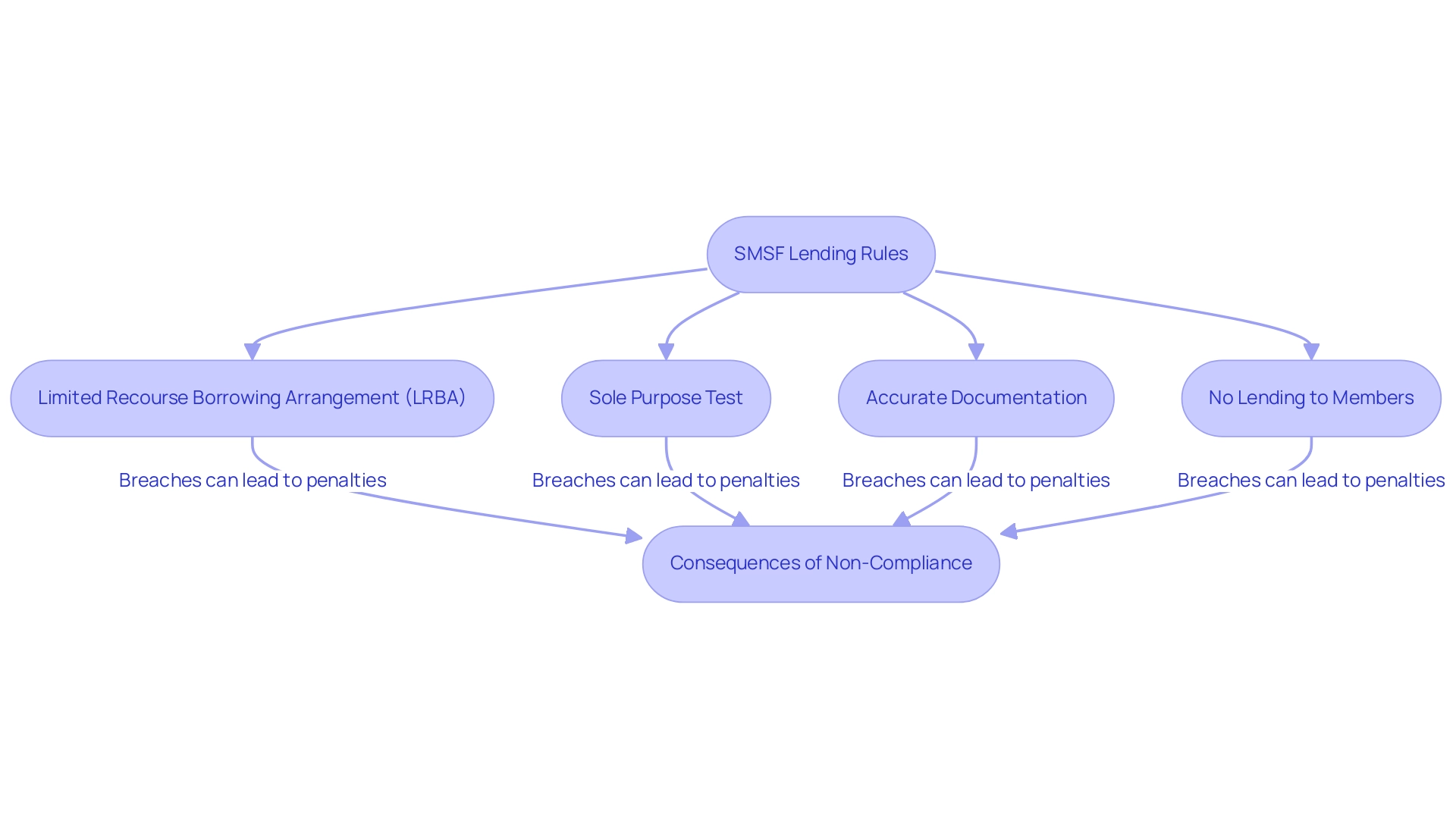
The Importance of Related Party Structures in SMSF Lending
Related party structures play a pivotal role in self-managed superannuation fund (SMSF) lending, particularly in ensuring compliance with Australian Taxation Office (ATO) regulations. A related party encompasses any individual or entity closely linked with superannuation fund members, including family members and business associates. Notably, SMSF lending rules prohibit a self-managed super fund from lending money to a related party, as this contravenes the Sole Purpose Test, which is vital for maintaining compliance.
Transactions involving these parties must strictly adhere to the arm's length principle. This principle mandates that the terms of any loan or funding must reflect prevailing market rates and conditions. Adherence to this principle is essential, as it helps prevent breaches of superannuation laws that could lead to severe penalties and the forfeiture of tax concessions.
At Finance Story, we understand the complexities of utilizing Self-Managed Superannuation Funds for commercial property ventures. Statistics indicate that a significant portion of SMSFs—approximately 24.6%—holds 50% or more of their assets in listed shares. This underscores the importance of comprehending related party transactions within the context of asset allocation. It is imperative for financial professionals to educate their clients about these structures to mitigate risks associated with non-compliance.
Expert opinions underscore that adherence to the arm's length principle not only safeguards the integrity of the fund but also enhances compliance rates, fostering a more resilient economic environment. As Tim Miller articulates, "The trustee or an investment manager of a regulated superannuation fund must not lend money of the fund to: a member of the fund; or a relative of a member of the fund; or give any other financial assistance using the resources of the fund to: a relative of a member of the fund."
Case studies illustrate the impact of related party structures on SMSF lending rules. For instance, firms that adeptly navigate these complexities often leverage their access to a diverse portfolio of lenders, enabling them to present tailored options that comply with regulatory requirements. This adaptability is crucial in a landscape where compliance is under increasing scrutiny.
By ensuring that all transactions are conducted at arm's length, Finance Story empowers small business owners to maintain compliance and effectively optimize their self-managed super fund strategies.

Types of Loans Available Through SMSFs: Options and Considerations
Self-Managed Superannuation Funds (SMSFs) have access to a variety of loan options tailored to their financial goals, especially in the realm of commercial real estate investments, in accordance with the SMSF lending rules for office buildings, warehouses, and retail spaces. Among these, Limited Recourse Borrowing Arrangements (LRBAs) stand out as a preferred choice. These arrangements allow SMSFs to borrow funds specifically for acquiring a single asset, such as commercial real estate, while limiting the lender's recourse solely to that asset. This feature significantly mitigates risk for the fund, making it an attractive option for real estate ventures.
In addition to LRBAs, SMSFs can consider traditional bank loans and private loans, each presenting unique terms and conditions. Traditional bank loans may offer competitive interest rates but often come with stricter eligibility criteria. Conversely, private loans may provide greater flexibility, albeit at a higher cost. Financial experts guiding clients should meticulously evaluate these options, taking into account crucial factors such as the loan-to-value ratio (LVR), which typically averages around 70% for SMSF acquisitions, alongside related interest rates and repayment terms.
Recent statistics reveal that the total value of LRBAs held by SMSFs has seen fluctuations, with a notable decrease of $1 billion to $56.3 billion, primarily associated with expenditures in residential real estate. This trend highlights the necessity of understanding current market dynamics and the types of loans available for SMSFs, especially in light of the SMSF lending rules set for 2025. Finance Story, with its deep insight into the finance sector and a comprehensive array of lenders, is well-positioned to assist clients in navigating these trends and securing the most suitable financing solutions for their commercial ventures.
Case studies illustrate successful SMSF funding strategies utilizing various loan types. For instance, consider a hypothetical scenario where a client of Finance Story leveraged an LRBA to acquire a commercial property. This strategy not only diversified their portfolio but also maximized potential rental income, showcasing the strategic advantages of such arrangements.
Expert insights from mortgage brokers underscore the importance of customizing loan options to align with individual client circumstances. As Shaun Backhaus, Director of DBA Lawyers, observes, "Monetary product advice can only be obtained from a licensed adviser under the Corporations Act 2001 (Cth)." By fully understanding the characteristics of available loans, financial experts can effectively guide their clients in selecting the most appropriate financing options that align with their financial strategies and long-term objectives.
To explore tailored solutions for your self-managed super fund commercial property investments, book a chat with Finance Story today.
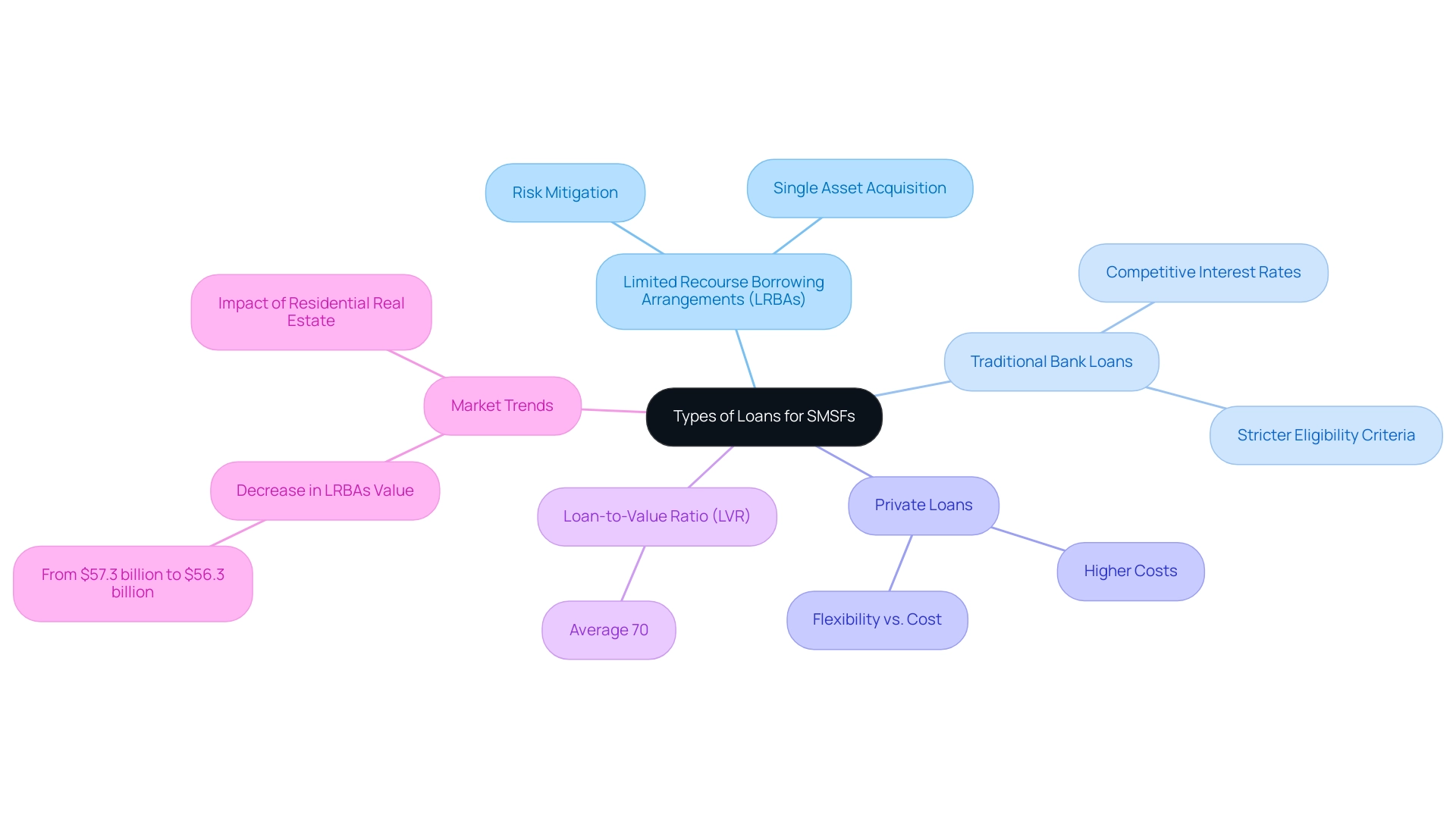
Understanding the Arm's Length Principle in SMSF Transactions
The arm's length principle stands as a cornerstone of self-managed superannuation fund transactions. The SMSF lending rules mandate that all dealings between the self-managed superannuation fund and its members or related parties occur under commercial terms. This principle is crucial for ensuring that transactions adhere to the SMSF lending rules, ensuring they are equitable and reflect true market value. By doing so, it safeguards the fund from potential compliance issues. For instance, when a self-managed superannuation fund acquires a property from a related party, the sale price must align with what an independent buyer would reasonably pay in the open market.
Educating clients about the arm's length principle is essential for financial professionals. Failure to adhere to the SMSF lending rules can lead to significant penalties and tax repercussions. Recent statistics indicate that inaccurate or outdated valuations can result in non-compliance and mislead members, highlighting the risks associated with not adhering to the arm's length principle. Such missteps jeopardize the integrity of the fund and threaten the retirement savings of its members in accordance with the SMSF lending rules.
Emma Rosenzweig, Deputy Commissioner of Superannuation and Employer Obligations, emphasizes the importance of the self-managed super fund sector. She states, "The self-managed super fund sector is a large and growing part of the superannuation system, and it is critical that we continue to support it to operate effectively and with integrity to safeguard the retirement savings of many Australians."
As small business owners contemplate utilizing their self-managed superannuation fund for commercial property investments, understanding the SMSF lending rules and the arm's length principle becomes even more essential. A notable case study highlights the new requirement for self-managed superannuation fund trustees to obtain a director ID, enhancing accountability within the sector. This regulation underscores the importance of compliance and the need for trustees to be proactive in meeting their obligations.
As the self-managed superannuation fund sector continues to evolve, maintaining a strong grasp of the SMSF lending rules and their implications is vital for ensuring the long-term success and integrity of these funds. Furthermore, organizations such as Finance Story are offering customized support and thorough training on self-managed superannuation funds, emphasizing the significance of remaining knowledgeable about regulations and navigating the intricacies of commercial real estate.
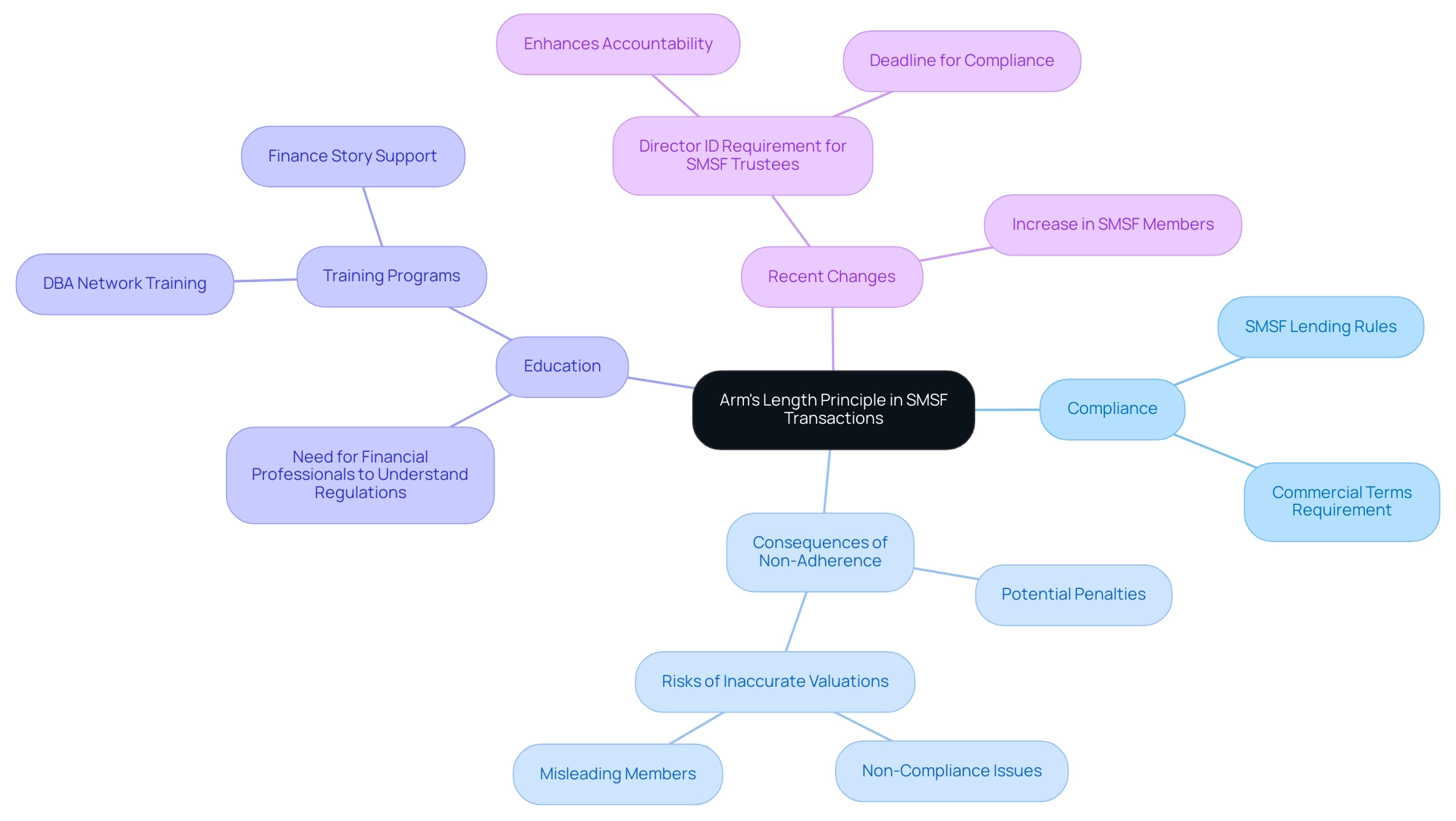
Risks and Challenges in SMSF Lending: What Professionals Should Know
The risks and challenges associated with self-managed superannuation fund lending rules are numerous, necessitating efficient management by financial experts, particularly in the context of commercial real estate ventures. Market risks are particularly pronounced, as fluctuations in real estate values can significantly impact the overall performance of a self-managed super fund. Recent trends indicate that market volatility can lead to substantial variations in real estate valuations, thereby affecting the fund's asset base and financial returns.
Cash flow issues represent another critical concern. If an investment asset fails to generate adequate rental income, it may impede the fund's ability to meet loan repayments, potentially resulting in financial strain. This underscores the necessity for experts to assist their clients in selecting assets with robust rental potential and ensuring that the self-managed super fund maintains sufficient liquidity to address unforeseen costs.
The importance of compliance risks cannot be overstated when considering SMSF lending rules. The Australian Taxation Office (ATO) enforces stringent regulations governing these rules, and non-compliance can lead to severe penalties, including trustee disqualification and loss of tax concessions. In 2021, for instance, 205 trustees faced disqualification due to regulatory breaches, highlighting the critical nature of adhering to ATO guidelines.
Moreover, tax agents and auditors with outstanding personal superannuation fund lodgment obligations have received red warning letters, serving as a final notice before potential disqualification. This situation emphasizes the urgency of compliance.
Finance Story offers tailored guidance for navigating self-managed superannuation fund commercial property investments, ensuring clients are well-informed about compliance and lender selection. Financial experts should stress the importance of comprehensive due diligence prior to entering agreements under the SMSF lending rules. This involves understanding the nuances of the lending landscape, such as the higher default multiples applied to self-managed superannuation fund loans, which reflect the inherent risks associated with compliance and the complexities of underwriting.
As Erin Kitson, a Primary Credit Analyst, notes, "These multifaceted factors are why we apply a higher default frequency to self-managed superannuation fund loans in our RMBS analysis." Such insights necessitate a cautious approach to SMSF lending rules.
Furthermore, the impact of market fluctuations on self-managed superannuation fund property values is significant. Professionals should encourage trustees to stay informed about market trends and to regularly evaluate their investment strategies in response to changing economic conditions. Developing sound monetary habits early in the fund's lifecycle is essential for long-term success, enabling trustees to make informed decisions based on their financial figures, including fees, returns, and associated risks.
The regulator emphasizes the importance of trustees understanding their duties and responsibilities when managing a self-managed super fund, urging them to be aware of their financial figures to make informed decisions.
In summary, understanding the risks linked to self-managed superannuation fund lending is crucial for financial professionals. By providing clients with comprehensive insights and guidance, particularly through the expertise of Finance Story, they can help ensure that SMSFs are managed effectively and in compliance with regulatory requirements.
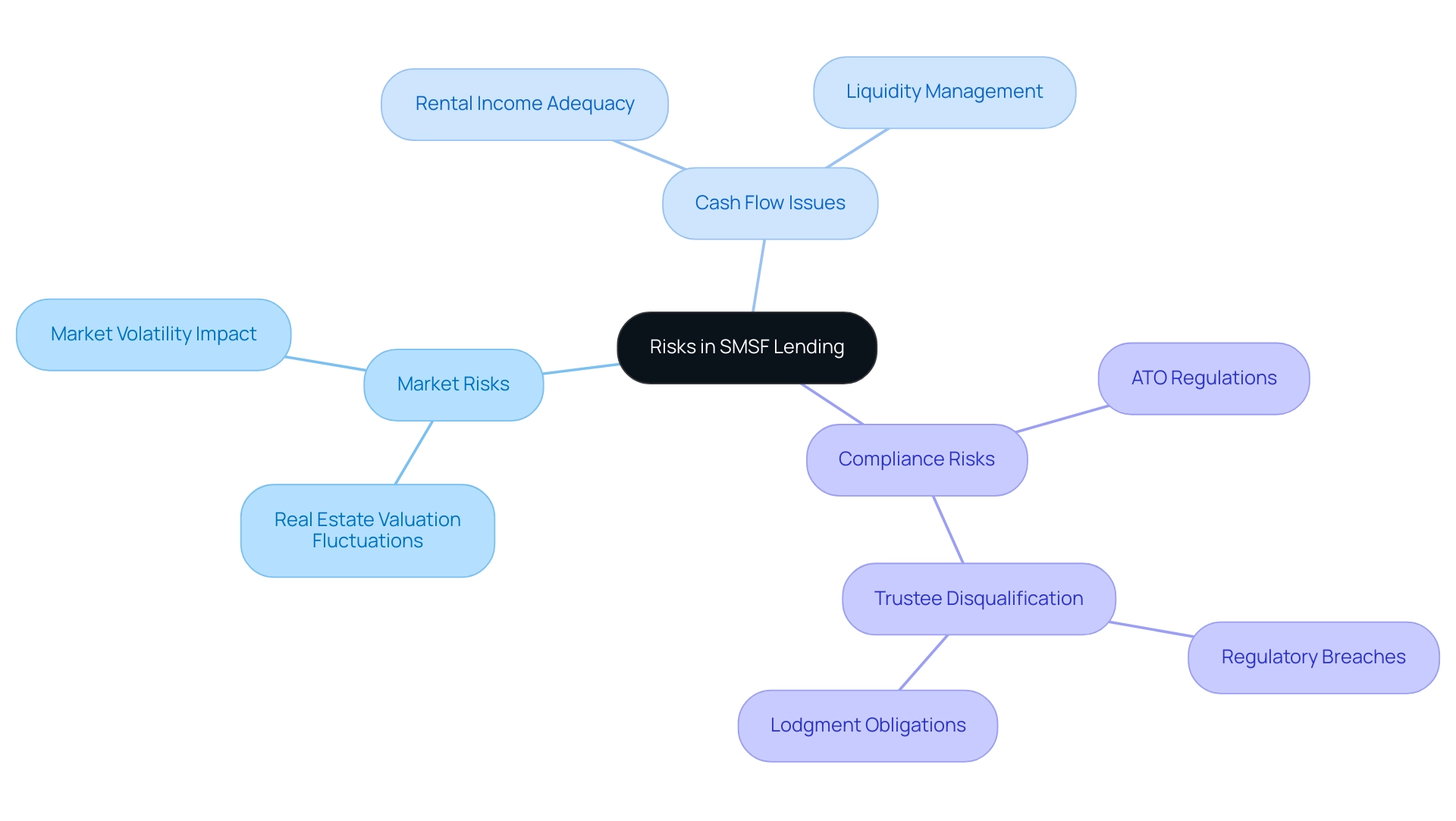
Best Practices for Advising Clients on SMSF Lending
To effectively assist clients with self-managed superannuation fund (SMSF) lending, professionals must implement several key best practices, particularly in alignment with SMSF lending rules when using self-managed superannuation funds for commercial property investments.
Firstly, it is crucial for clients to understand the implications of borrowing through their SMSF, including the inherent risks and compliance obligations associated with SMSF lending rules. This understanding is vital, especially considering that there are approximately 15,480 financial advisers in Australia available to provide insights into these complexities, underscoring the importance of seeking professional advice from various experts, such as those at Finance Story.
Regular assessments of the fund's investment strategy and performance are essential to ensure alignment with the client's retirement goals. This practice not only aids in tracking progress but also facilitates necessary adjustments in response to market changes or personal circumstances. Statistics indicate that consistent evaluations can significantly enhance the effectiveness of self-managed super fund management, reinforcing the necessity of these reviews.
Furthermore, professionals should advocate for clients to seek independent legal and financial advice when structuring loans or engaging in intricate transactions. This multi-faceted approach ensures that clients are well-informed and protected, particularly when navigating the complexities of self-managed super fund commercial property investments.
Fostering open communication is another cornerstone of successful advisory strategies. By maintaining ongoing support and dialogue, advisors can assist clients in navigating the intricacies of SMSF lending rules. For instance, establishing a clear exit strategy from the outset can mitigate potential complications, as highlighted in the case study titled "Exit Strategy for Self-Managed Super Funds," where clients were equipped with a comprehensive understanding of the steps involved in winding up their funds.
Moreover, it is important to note that SMSFs may still be suitable for clients with lower balances if they can manage administration effectively or expect large contributions soon. By integrating these best practices, investment professionals can empower their clients to make informed decisions, ultimately leading to more successful outcomes in accordance with SMSF lending rules. As Eliza Bavin, the former deputy governor of the Reserve Bank of Australia, emphasizes, the role of professional advice is crucial in navigating these complex economic landscapes, especially when considering the tailored guidance offered by Finance Story for compliance and lender selection.
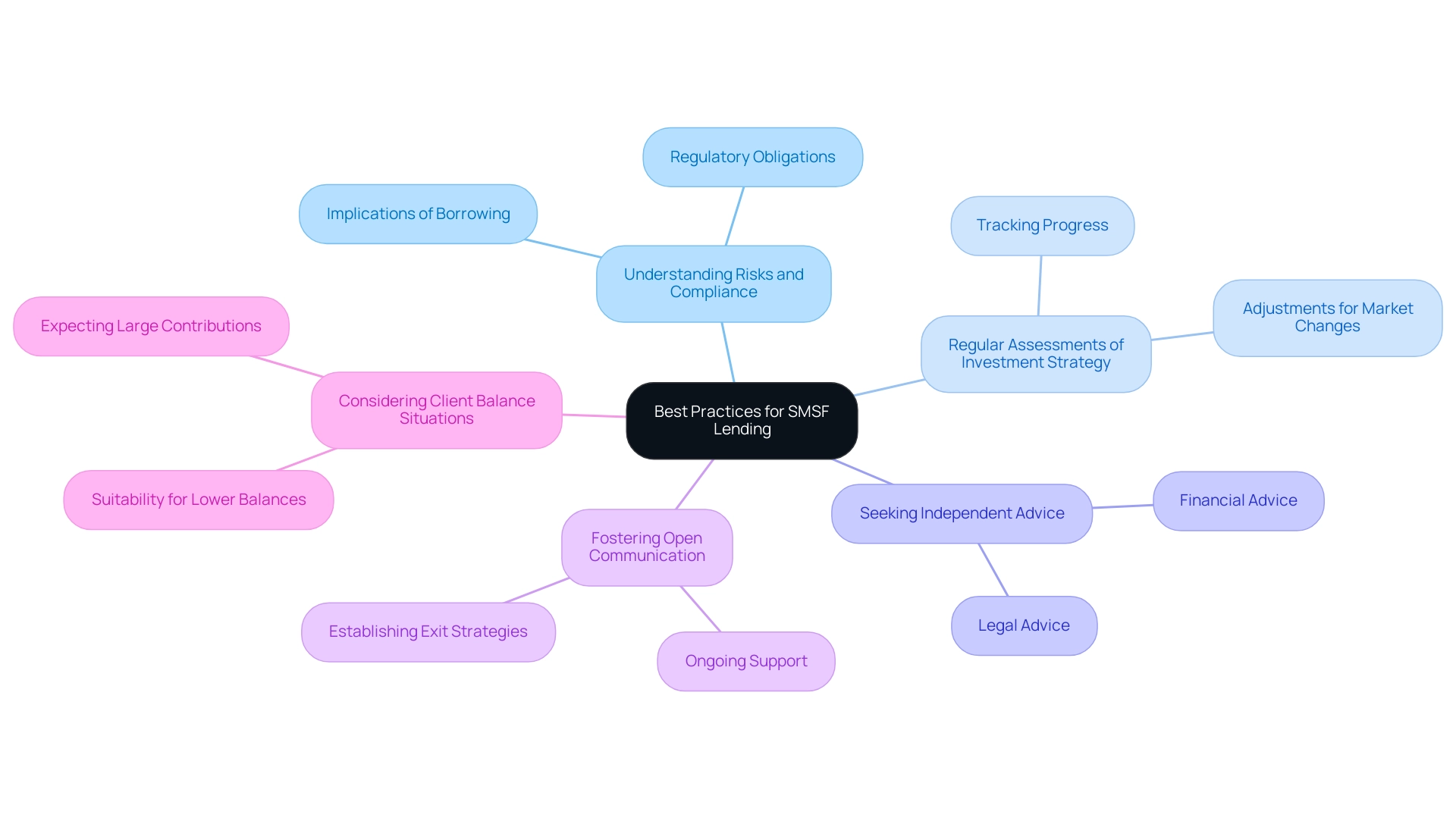
Future Trends and Considerations in SMSF Lending
The self-managed super fund (SMSF) lending environment is undergoing significant transformation, particularly in the realm of commercial real estate. Financial experts must closely monitor the emerging trends as we approach 2025, where increased regulatory scrutiny is expected, especially concerning SMSF lending rules for borrowing. This shift is critical; recent data reveals that New South Wales now accounts for 37.8% of new SMSFs, while Victoria's share has decreased to 27.1%.
These developments underscore the evolving dynamics within the SMSF sector, highlighting the necessity for advisors to stay informed about SMSF lending rules and compliance requirements. Additionally, the growing popularity of SMSFs as a vehicle for acquiring real assets suggests that more clients will seek guidance on leveraging their superannuation for commercial real estate investments, including office buildings, warehouses, and retail spaces. Finance Story is prepared to assist you in constructing a robust case and ensuring regulatory compliance, ready to connect you with the ideal lender for your commercial asset.
This trend is further illustrated by the average loan size for owner-occupier properties in the Australian Capital Territory, which stands at $377,000, reflecting increasing interest in real estate through SMSFs. Moreover, the typical SMSF value is currently $1,536,625, down from $1,564,253, indicating a need for tailored financial solutions as clients navigate their investment strategies. Technological advancements are poised to revolutionize the SMSF lending process.
Innovations in financial technology can streamline lending processes and enhance compliance tracking, simplifying the management of client needs for advisors. By embracing these technological advancements, financial professionals can elevate their service delivery and maintain competitiveness in a rapidly changing market.
In summary, by proactively addressing these emerging trends and regulatory shifts, advisors can position themselves as trusted partners in their clients' financial journeys. This ultimately empowers clients to navigate the complexities of SMSF lending with confidence. Understanding client needs and leveraging customized data will be vital in this evolving landscape, particularly regarding SMSF lending rules for investing in commercial properties.
BOOK A CHAT.
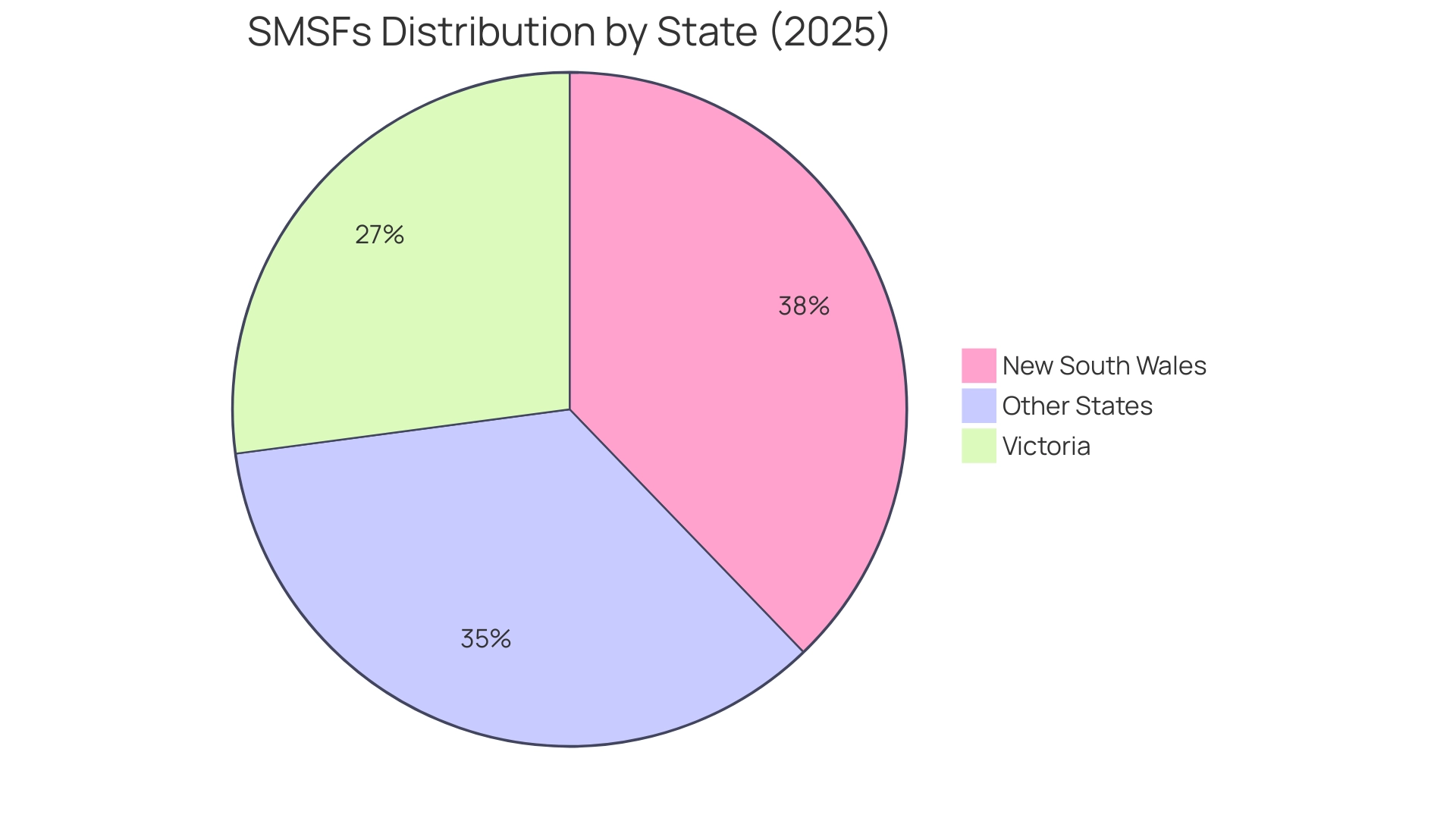
Conclusion
The landscape of Self-Managed Super Funds (SMSFs) and their lending capabilities presents a wealth of opportunities for individuals seeking to enhance their retirement savings through property investments. This article has explored the significance of SMSF lending, emphasizing its ability to empower investors with greater control and the potential for substantial growth. With the SMSF sector boasting impressive assets, understanding the regulatory framework and compliance requirements is crucial for both financial professionals and investors.
Key regulations, such as the limited recourse borrowing arrangement and the arm's length principle, play a vital role in maintaining the integrity of SMSFs. Adhering to these guidelines not only safeguards retirement savings but also fosters a compliant investment environment. Furthermore, the importance of related party structures and the potential risks associated with market fluctuations further underscore the need for comprehensive knowledge and proactive management in SMSF lending.
As the SMSF lending landscape evolves, staying informed about emerging trends and best practices is imperative for financial professionals. By embracing technological advancements and maintaining open communication with clients, advisors can navigate the complexities of SMSF lending effectively. Ultimately, the strategic use of SMSFs for property investments not only supports individual retirement goals but also contributes to a robust financial future. Engaging with knowledgeable partners, such as Finance Story, can further enhance the journey towards successful SMSF investment strategies.

